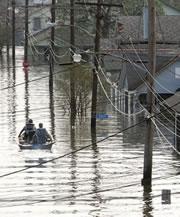 Within the city, levee walls broke in stretches hundreds of metres long, even though the water didn't reach their tops.© AP Photo/Dave Martin
Within the city, levee walls broke in stretches hundreds of metres long, even though the water didn't reach their tops.© AP Photo/Dave MartinMembers of the US Senate heard testimony this week from engineers who studied what happened to the levees in New Orleans during Hurricane Katrina in August.
Their preliminary report has yielded a list of errors that led to the failure of the levees and the disastrous flooding of the city - and the meeting included the suggestion that faulty construction may have been to blame.
Most of the levees failed in the manner suspected at the time of the flood: they were overtopped by encroaching water, which ate away at the unprotected side and caused them to fall. But the major breaks within the city itself happened without the levees being overtopped.
"It was human error in the design and construction of the levees that led to a significant part of the flooding of New Orleans," said Senator Joe Lieberman, the ranking Democrat on the Senate Committee on Homeland Security and Governmental Affairs, of the breaks within the city.
“Perhaps not just human error was involved. There may have been some malfeasance.”
Raymond Seed
University of California, Berkeley
Raymond Seed, an engineer from the University of California, Berkeley, who headed one of the investigating teams, added a caveat: "Perhaps not just human error was involved. There may have been some malfeasance. Some of the sections may not have been constructed as they were designed."
Seed said they had received unproven allegations of improper construction from the community, and had found clear differences between some of the broken levees and the design drawings. He said investigations would continue.
Under and over
The city of New Orleans and the surrounding area, much of which lies below sea level, relies on a complex system of levees and floodwalls designed by the Army Corps of Engineers and run by a variety of organizations. These levees, extending for more than 560 kilometres and sitting up to 6 metres above the ground, have a variety of designs and were built by many different contractors. Many of these breached, in several different ways.
"What we found in the field was very different than what we had expected, given what we had seen in the media reports," said Peter Nicholson, leader of the American Society of Civil Engineers' levee assessment team. "Rather than a few breaches through the floodwalls in the city caused largely by overtopping, we found literally dozens of breaches throughout the many miles of levee system."
The teams found that outside the city, many dozens of levees were overtopped by waters from lakes and rivers, which were at abnormally high levels because of the winds and pressure of the hurricane.
Some of these stood; others collapsed because of erosion created by the water pounding down on dry ground. The difference, according to a report put out jointly by several investigative teams, was often whether levees were "I" walls, which have vertical sides, or "T" walls, shaped like the inverted letter, that stood firmer.1
But within the city itself, the teams found that the walls broke in stretches hundreds of metres long, even though the water did not rise as high as their tops.
Chain reaction
Most of these walls were made of metal barriers buried 3 metres underground. Earth was heaped up on each side, and the surface portion encased in a concrete wall.
It seems that the soil under the walls, which like most of the city was once marsh, became more porous over time. So when a storm surge pushed across Lake Pontchartrain and into the canals, the water flowed through the soil under the walls and eroded the entire foundation.
Once one section collapsed, it tended to cause adjoining sections to collapse too. The resulting breaches caused flood bursts that pushed land, trees and sheds almost 15 metres away from the canals.
ADVERTISEMENT
Seed and others stressed that having the levees run by a variety of local agencies is a bad idea, as the system is only as good as its weakest link. He added that the Army Corps of Engineers suffers from a lack of funding and staff.
"We have strangled the corps of engineers in terms of budgets and support; they responded by doing what was necessary to get their jobs done as best they could," said Seed. "The human-error issue in New Orleans is not something we can be pointing fingers at the corps for."
University of California, Berkeley
-
References
-
Preliminary Report on the Performance
of the
New Orleans Levee Systems in
Hurricane Katrina on August 29, 2005, http://hsgac.senate.gov/_files/
Katrina/Preliminary_Report.pdf (2005).
-
Preliminary Report on the Performance
of the
